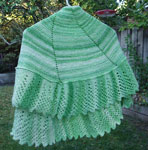
Circular Baby Blanket
Yarn: Handspun Superwash Wool from Crown Mountain Farm’s Superwash Merino in “Say A Little Prayer” colorway. I spun 1.5 pounds. The blanket weighs 1 pound 3 ounces. It’s a 2-ply that is spun to DK/light worsted weight.
Needle: US #9
Gauge: 18 sts/4″ (10cm)
Pattern: Variation of the Pinwheel Baby Blanket with Godmother’s Edging from Barbara Walker’s Second Treasury.
Finished Size: 46.5″ diameter
This particular baby blanket was knit up to 50 sts per panel (500 sts around), before I started the edging. At this stage, the blanket was 34″ in diameter. The edging is 6.5″ wide. Believe me, it’s large enough as a nap blanket. As me how I know…
I am not blocking this blanket. I want this to be a drag everywhere blanket for the new mother. And I doubt that she will have much time for anything, except tossing this blanket into the washer/dryer and pulling it back out again.
The center worked up very quickly, but the edging took forever. I timed it to be approximately 2 Tivo hours per panel, or approximately 1.75 hours. Multiply that by 10. There was a lot of TV watching, P&P reading, and wine drinking/socializing during all of this.
The good news? This is a very easy pattern to memorize — both the center and the edging. The center only has 2 rows: increase row and knit around row. Every wrong side row on the edging is plain knit, except for one, so there is only 6 pattern rows to remember. It’s very geometric, so it’s easy to figure out where you are in the pattern.
While none of the components of this baby blanket is original. They are all published information. I thought the juxtaposition of the components are original. But, once I set the blanket on the table for the photo shoot, I realized that something about it looks familiar. I went back to Best of Knitter’s Shawls and Scarves. Yup. Joan Schrouder already came up with the same combination. The only consolation that I have is that Silk Swirl has 8 panels instead of the 10 in the Pinwheel Baby Blanket.
The reason that I think the 10 panel pinwheel and the Godmother’s Edging work so well together is that the edging is a 10 row repeat. So, it doesn’t really matter when you decide to stop; you will always be able to work the edging and be assured that the stitch count will come out right. That is, if you aren’t under the influence of vicodin and somehow messed up your increases. I still don’t understand how that happened.
In the past few weeks, I’ve been on a Jane Austen kick. I’ve re-read Pride and Prejudice, watched Becoming Jane and the BBC version of Emma. During Emma, I looked at the shoulder shawls that the ladies were wearing. Hmm. It’s a lot like the baby blanket folded in half and thrown over the shoulders.


Yup. It works beautifully as a shoulder shawl. Except that 90+F weather is not the best time to be trying it out. I am thinking that I want one of these for myself, except maybe in sport weight yarn.



